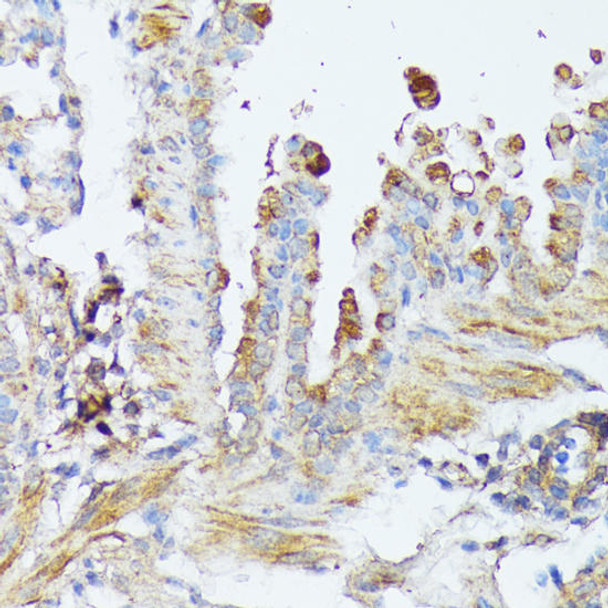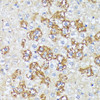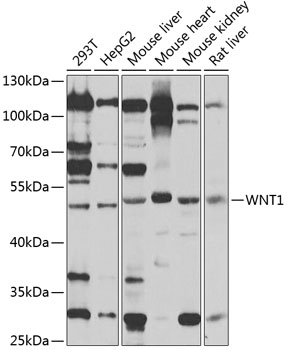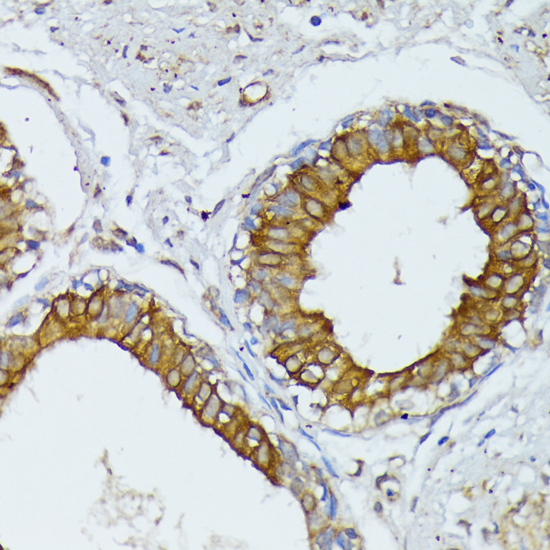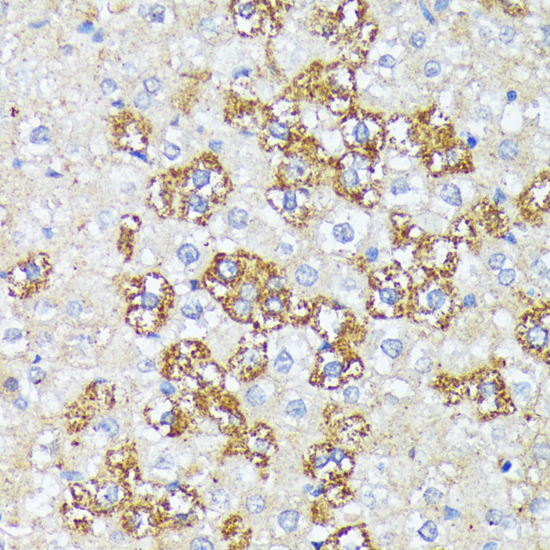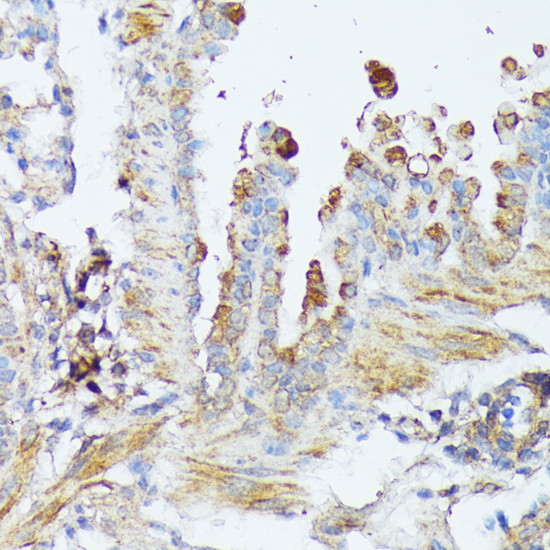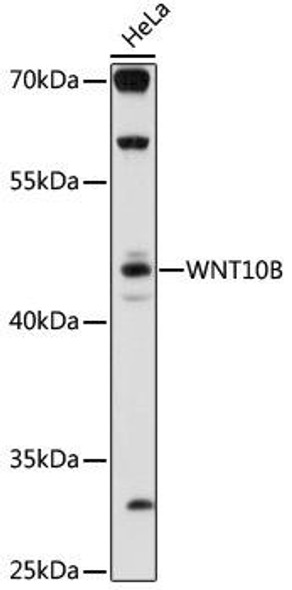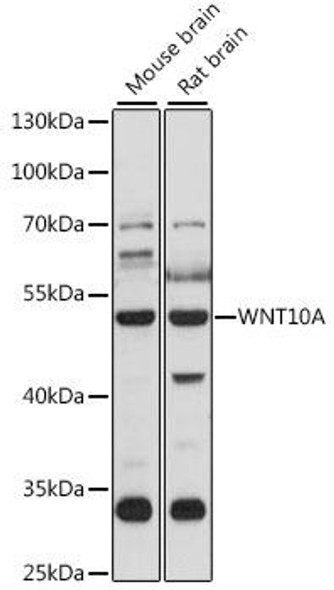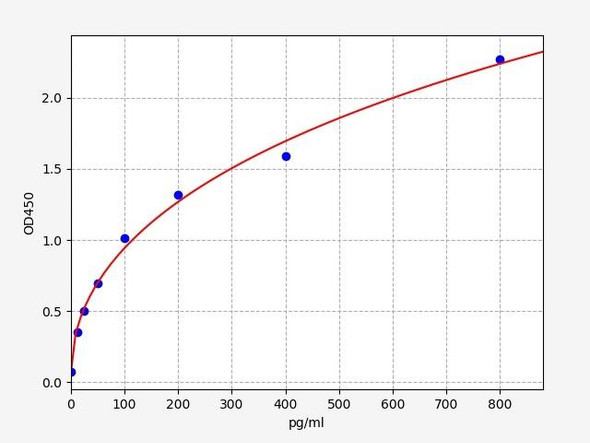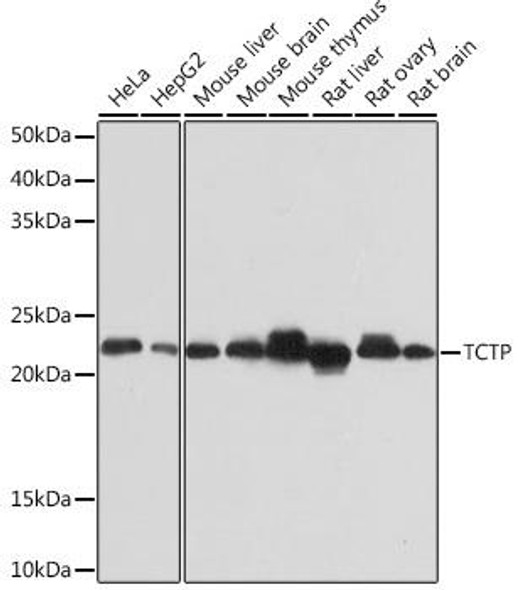Description
Anti-WNT1 Antibody (CAB2475)
The WNT1 Polyclonal Antibody (CAB2475) is a valuable tool for researchers studying the WNT1 protein, a signaling molecule involved in cell growth and development. This antibody, raised in rabbits, is highly specific for WNT1 in human samples and has been validated for use in Western blot applications. By binding to the WNT1 protein, this antibody allows for accurate detection and analysis in a variety of cell types, making it ideal for studies in developmental biology and cancer research.WNT1 is a key player in the Wnt signaling pathway, which is crucial for embryonic development, tissue regeneration, and stem cell maintenance.
Dysregulation of WNT1 has been linked to various diseases, including cancer, neurodegenerative disorders, and osteoporosis. By investigating the function of WNT1, researchers can gain insights into the mechanisms underlying these conditions and potentially identify new therapeutic targets for drug development.Overall, the WNT1 Polyclonal Antibody is a valuable tool for studying the role of WNT1 in various biological processes and diseases, offering researchers the opportunity to delve deeper into the molecular mechanisms driving these complex pathways.
| Antibody Name: | Anti-WNT1 Antibody |
| Antibody SKU: | CAB2475 |
| Antibody Size: | 20uL, 50uL, 100uL |
| Application: | WB IHC |
| Reactivity: | Human, Mouse, Rat |
| Host Species: | Rabbit |
| Immunogen: | Recombinant fusion protein containing a sequence corresponding to amino acids 231-370 of human WNT1 (NP_005421.1). |
| Application: | WB IHC |
| Recommended Dilution: | WB 1:1000 - 1:4000 IHC 1:50 - 1:200 |
| Reactivity: | Human, Mouse, Rat |
| Positive Samples: | 293T, HepG2, Mouse liver, Mouse heart, Mouse kidney, Rat liver |
| Immunogen: | Recombinant fusion protein containing a sequence corresponding to amino acids 231-370 of human WNT1 (NP_005421.1). |
| Purification Method: | Affinity purification |
| Storage Buffer: | Store at -20'C. Avoid freeze / thaw cycles. Buffer: PBS with 0.02% sodium azide, 50% glycerol, pH7.3. |
| Isotype: | IgG |
| Sequence: | TCWM RLPT LRAV GDVL RDRF DGAS RVLY GNRG SNRA SRAE LLRL EPED PAHK PPSP HDLV YFEK SPNF CTYS GRLG TAGT AGRA CNSS SPAL DGCE LLCC GRGH RTRT QRVT ERCN CTFH WCCH VSCR NCTH TRVL HECL |
| Gene ID: | 7471 |
| Uniprot: | P04628 |
| Cellular Location: | Secreted, extracellular matrix, extracellular space |
| Calculated MW: | 40kDa |
| Observed MW: | 49kDa |
| Synonyms: | WNT1, BMND16, INT1, OI15 |
| Background: | The WNT gene family consists of structurally related genes which encode secreted signaling proteins. These proteins have been implicated in oncogenesis and in several developmental processes, including regulation of cell fate and patterning during embryogenesis. This gene is a member of the WNT gene family. It is very conserved in evolution, and the protein encoded by this gene is known to be 98% identical to the mouse Wnt1 protein at the amino acid level. The studies in mouse indicate that the Wnt1 protein functions in the induction of the mesencephalon and cerebellum. This gene was originally considered as a candidate gene for Joubert syndrome, an autosomal recessive disorder with cerebellar hypoplasia as a leading feature. However, further studies suggested that the gene mutations might not have a significant role in Joubert syndrome. This gene is clustered with another family member, WNT10B, in the chromosome 12q13 region. |
| UniProt Protein Function: | WNT1: Ligand for members of the frizzled family of seven transmembrane receptors. In some developmental processes, is also a ligand for the coreceptor RYK, thus triggering Wnt signaling. Probable developmental protein. May be a signaling molecule important in CNS development. Is likely to signal over only few cell diameters. Belongs to the Wnt family. |
| UniProt Protein Details: | Protein type:Cell development/differentiation; Secreted, signal peptide; Motility/polarity/chemotaxis; Oncoprotein; Secreted Chromosomal Location of Human Ortholog: 12q13 Cellular Component: proteinaceous extracellular matrix; extracellular space; cell surface; endoplasmic reticulum lumen; Golgi lumen; cytoplasm; plasma membrane; extracellular region Molecular Function:protein domain specific binding; frizzled binding; cytokine activity; receptor agonist activity Biological Process: positive regulation of insulin-like growth factor receptor signaling pathway; positive regulation of transcription, DNA-dependent; T cell differentiation in the thymus; Wnt receptor signaling pathway through beta-catenin; ubiquitin-dependent SMAD protein catabolic process; diencephalon development; negative regulation of BMP signaling pathway; neuron differentiation; cerebellum formation; positive regulation of fibroblast proliferation; cell-cell signaling; midbrain development; positive regulation of cell proliferation; midbrain-hindbrain boundary maturation during brain development; response to wounding; positive regulation of Notch signaling pathway; myoblast fusion; neuron fate determination; organ regeneration; inner ear morphogenesis; Wnt receptor signaling pathway; cell fate commitment; embryonic axis specification; DNA damage response, signal transduction; negative regulation of fat cell differentiation; central nervous system morphogenesis; ureteric bud branching; forebrain anterior/posterior pattern formation; spinal cord association neuron differentiation; positive regulation of transcription from RNA polymerase II promoter; positive regulation of transcription factor activity; negative regulation of cell-cell adhesion; positive regulation of protein amino acid phosphorylation; negative regulation of transforming growth factor beta receptor signaling pathway; Spemann organizer formation Disease: Bone Mineral Density Quantitative Trait Locus 16; Osteogenesis Imperfecta, Type Xv |
| NCBI Summary: | The WNT gene family consists of structurally related genes which encode secreted signaling proteins. These proteins have been implicated in oncogenesis and in several developmental processes, including regulation of cell fate and patterning during embryogenesis. This gene is a member of the WNT gene family. It is very conserved in evolution, and the protein encoded by this gene is known to be 98% identical to the mouse Wnt1 protein at the amino acid level. The studies in mouse indicate that the Wnt1 protein functions in the induction of the mesencephalon and cerebellum. This gene was originally considered as a candidate gene for Joubert syndrome, an autosomal recessive disorder with cerebellar hypoplasia as a leading feature. However, further studies suggested that the gene mutations might not have a significant role in Joubert syndrome. This gene is clustered with another family member, WNT10B, in the chromosome 12q13 region. [provided by RefSeq, Jul 2008] |
| UniProt Code: | P04628 |
| NCBI GenInfo Identifier: | 139743 |
| NCBI Gene ID: | 7471 |
| NCBI Accession: | P04628.1 |
| UniProt Related Accession: | P04628 |
| Molecular Weight: | |
| NCBI Full Name: | Proto-oncogene Wnt-1 |
| NCBI Synonym Full Names: | wingless-type MMTV integration site family, member 1 |
| NCBI Official Symbol: | WNT1 |
| NCBI Official Synonym Symbols: | INT1; OI15; BMND16 |
| NCBI Protein Information: | proto-oncogene Wnt-1 |
| UniProt Protein Name: | Proto-oncogene Wnt-1 |
| UniProt Synonym Protein Names: | Proto-oncogene Int-1 homolog |
| Protein Family: | WNT1-inducible-signaling pathway protein |
| UniProt Gene Name: | WNT1 |




